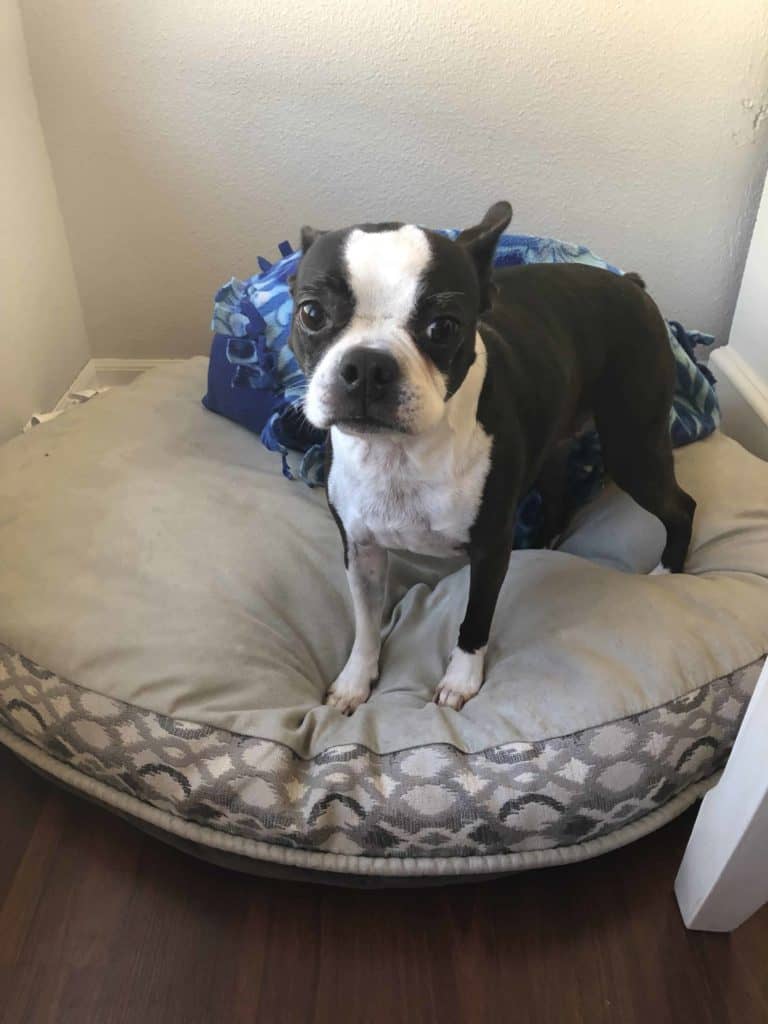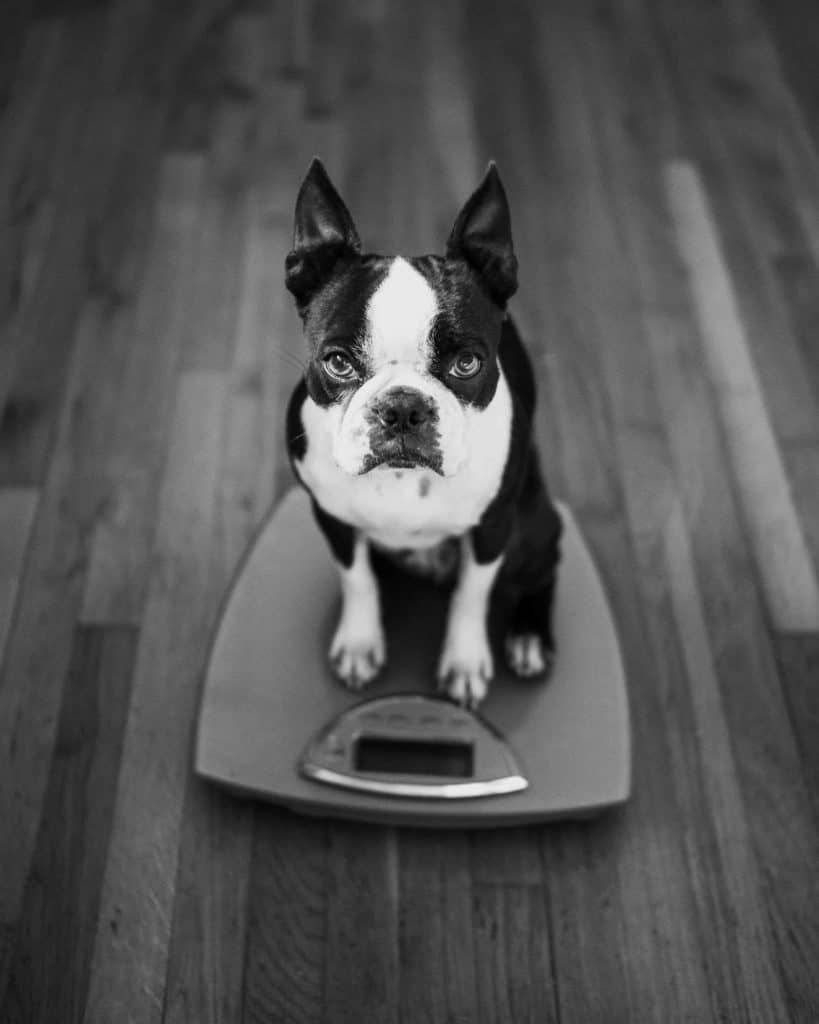It’s the cold, harsh truth we can’t keep our Boston Terriers young forever. As much as his personality may deny aging, their body can’t. You may start to notice a little less spring in your pup’s step and that he may be slower to rise in the morning.
Almost all dogs will face arthritis pain as they age and your Boston is no exception. Probably the worst part about this condition is that your pup isn’t going to let you know there’s a problem until he’s very sore.

What is Arthritis?
You’ve probably heard the term arthritis thrown around to describe any number of pain issues in older dogs, but the exact definition is any abnormal change to a joint. It can occur because of structural defects that cause misalignment of the joint, from infections, or disorders of the immune system, or most commonly by repeated stress and trauma to the joint. All of this adds up to inflammation and swelling in the joint. This is what causes a decrease in activity and stiffness and pain.
What Are the Signs That Your Boston Terrier Has Arthritis?
Boston Terriers can be such stoic little troopers that her arthritis may be more severe than she lets on. Keeping an eye out for even subtle changes in your Boston’s mood and activity may help clue you in she is suffering from some arthritic pain.
Decreased Activity
This may be hard to track in most Boston Terriers, but being less active can definitely point towards arthritis. It doesn’t necessarily mean that your dog is refusing to get off her bed, she just might not jump around as excitedly when greeting you. Or she might only want you to throw the ball for 20 minutes instead of half an hour.
Weight Gain

Decreased activity without a decrease in caloric intake equals weight gain. Even minor changes in activity levels can have your Boston looking more pleasantly plump than he was last month. If weight gain is gradual, it may be hard for you to notice so monthly weigh-ins may help you catch it before it gets too bad.
Licking or chewing
You may notice your Boston Terrier licking at his feet or biting at his tail more often as he ages. While there are definitely other causes for this behavior, arthritis should be on that list. Dogs will often lick, bite, or chew on areas that hurt to self-soothe.
Restlessness
If your pup has started pacing at night, it might not be nightmares, consider instead that she is uncomfortable lying down. Arthritis in the joints of the legs and even back cause pain when they’re forced to curl up under a body during sleep. Your Boston may also become more irritable due to lack of sleep and discomfort.
Muscle Atrophy
You may have noticed that older dogs seem to develop that skinny behind look. This is usually due to muscle wasting from less usage. When hips or leg joints have arthritis, your Boston does not use them as often or in the same way and the muscles kind of melt away as a result.
Limping
Most pups with arthritis aren’t going to show a consistent limp until the degenerative process has progressed pretty far. However, any limp in your older friend should be concerning and checked out by your vet.
The limp in Bella’s leg is how we found out she has arthritis. It was especially bad when she layed on the couch for a while then got up all of a sudden.
Have more health questions or need answers? Check out my article, 10 Common Boston Terrier Health Related Problems.
What To Do If Your Boston Terrier Has Arthritis
As with anything suspicious or ‘off’ in your older Boston Terrier, always consult with your vet. The earlier it is caught, the more luck your pup will have for pain-free mobility. Your veterinarian will start with a thorough examination in which they will move all joints back and forth to check for pain or decreased movement.
They will also press along your dog’s back to check for arthritis in the spine. Most of the time, the examination will be followed up with radiographs of the suspicious joints to confirm arthritis.
From there, you and your veterinarian will determine what treatments are necessary to relieve your Boston’s arthritic pain. It’s important to note that arthritis can’t be fixed, it can only be managed.
What Medications Are Available to Treat Arthritis in Boston Terriers?
According to veterinarian, Chyrle Bonk, it seems like there’s a new arthritis medication on the market every six months. And while it’s great to have that many options, it can sometimes make the decision of which one to use more difficult.
However, the abundance of choices makes it more likely that you will find one that is just right for your dog. Arthritis is best treated with a multimodal approach combining different medications. You should always consult your veterinarian before giving your pet any kind of medicine or supplement.
NSAID’s
Non-steroidal anti-inflammatory drugs like Rimadyl, Previcox, and Metacam make up a large group in arthritis treatment. NSAIDs work by reducing inflammation in affected joints and, therefore, decreasing pain. It’s essential to use only those NSAIDs that are meant for dogs as the human ones might not be safe. And even those intended specifically for dogs still come with a risk.
Steroids
If a more potent anti-inflammatory is needed, steroids like prednisone and dexamethasone may be added to the treatment regime. While they do work great at decreasing pain and swelling in arthritic joints, long-term use of steroids can actually contribute to joint damage. And lead to other health concerns like Cushing’s.
Pain Relievers
Other pain-relieving drugs such as Tramadol and gabapentin can be combined with either steroids or NSAIDs to decrease pain in severely affected dogs. Pain relievers don’t reduce inflammation they just block pain, which is why they are best when used in conjunction. Some of these medications can be habit-forming, so they should be used with caution.
Supplements
An increasingly popular group in arthritis treatment is the use of supplements, mainly glucosamine, chondroitin, and MSM. These work by helping to increase joint fluid production and prevent further joint injury to help decrease the discomfort of arthritis.
Most supplements take a month or more to reach their full effect, so it’s best to give them in conjunction with an anti-inflammatory. There are even injectable supplements on the market to help rebuild joint cartilage and increase joint fluid.

At-Home Remedies For Arthritis in Boston Terriers
As we said before, the treatment of arthritis is a multimodal approach, it shouldn’t be confined to just medications alone. In fact, the more ways you can come after it, the more comfortable your pup will be.
Weight Loss
If your Boston Terrier happens to be carrying around a little extra baggage, starting a weight loss program will really help decrease arthritis pain. Since arthritis makes it uncomfortable to exercise, you should start by cutting calories. Think about switching to a reduced or low-calorie diet or simply trim down the amount that you’re feeding. Once you get your dog’s weight under control, you can move onto other strategies.
Low-Impact Exercise
It may seem a little counterintuitive but exercise is actually really great for arthritis. I’m not suggesting that you start training your older pup for the doggy Olympics, instead pick out some low-impact exercises to get those joints moving.
Walking, especially up a slight incline, is a great activity and will help rebuild those atrophied muscles.
Swimming is the ultimate low-impact activity if you have the access and your pup has the desire.
You’ll want to avoid things like running, jumping, and quick twists until you get your Boston’s arthritic pain under control.
PROM
Passive Range Of Motion exercises is really great for working out those aching joints without putting excess stress on them. Think of these as physical therapy and do just 10-15 minutes two to three times per day.
Ice And Massage
Nothing relieves inflammation better than a little ice. Make your dog a couple of flexible ice packs by mixing rubbing alcohol and water. You can ice those sore joints after a long day for just 10 or 15 minutes, whatever your Boston Terrier will tolerate. After icing the area, get a little bonding time in by massaging the sore spots. It’s just as it sounds, simply rub the areas over the joints and watch how your pup melts in your hands.
As you can see, there are many ways out there to help your arthritic Boston. Working with your veterinarian will help you to formulate a game plan to get that pain under control.
Final thoughts…
Arthritis in Boston Terriers is one of those less than desirable issues that come with aging. Hopefully, this has helped you to develop a little more understanding of the disease and how you can spot it as soon as possible.
Getting your veterinarian involved is not only necessary, but it is also the best way to get your Boston Terrier’s arthritis under control. This way she can return to being your bouncy best friend in no time.
Have you dealt with arthritis in your dog? How have you helped your pet deal with arthritis? Please let us know by leaving a comment below.
References
- PetMD – How To Treat Arthritis In Dogs
- Adamson Veterinary Services – Passive Range Of Motion Exercises
